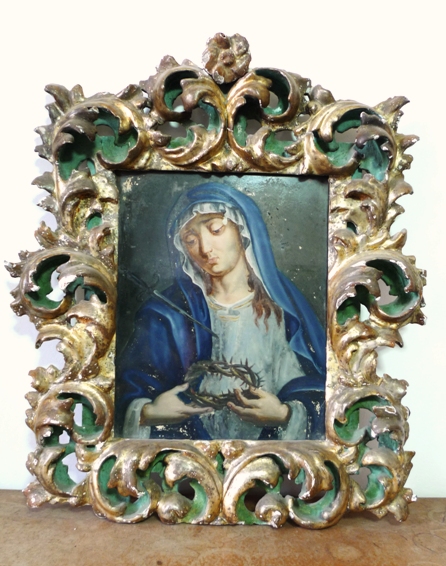In the same period of time, the representation of the Addolorata, without the sword, which contemplated the instruments of the Passion. It is the iconography of the Virgin of solitude or La Soledad inspired by a religious legend that tells of the Madonna left alone, after the death of her son, in a chapel opposite Calvary until the day of the Resurrection. This last theme was treated in a special way by the Spanish artists who worked in the climate of the Counter-Reformation and it spread also to Sicily, where in 1590 the brotherhood of Our Lady of Soledad was founded in Palermo. The iconography of the painting in question appears as a synthesis of the two subjects for the presence of both the sword that pierces the heart of the Madonna and the crown of thorns, object of contemplation of the Virgin.
Our Lady of Sorrows

Author: Unknown painter
Date: End sec. XVII
Material: Oil on glass
Dimensions: cm 41×31.5
Place: Milazzo, church of the SS. Crucifix in San Papino
The painting, which was probably originally placed at the feet of the Crucifix in the chapel of San Papino church, depicts the Sorrowful Madonna, pierced by a sword while contemplating the crown of thorns that he holds in his hands. The slightly reclined garment is framed by a white cap that lets out the hair movements on the shoulder, while the blue veil partially covers the white dress, bordered with gold. The subject of the Sorrowful Madonna is presented as a simplification of the Seven Sorrows of the Virgin, theme depicted with the iconographic attribute of seven swords that wound the heart of Mary. It is a faithful representation of what is read in the gospel of Luke about the prophecy that Simeon made to Mary, the day of the presentation of Jesus at the Temple, revealing that a sword would pierce her soul. This subject, which in the sixteenth century interested mainly artists of northern Europe, is found in Italian and Spanish works during the seventeenth century.
The general setting of the painting seems to be based on a model, perhaps known through the circulation of engravings that were disseminated to give impetus in the seventeenth century to the cult of Our Lady of Sorrows. However, the rendering of the shading of the face, the soft draping and the anatomical details reveal the hand of a skilled artist capable of mastering the technique of painting on glass. It must be considered the fact that glass painting is characterized by the constant use of prints, drawings and models derived from monumental size paintings, as often happens in the coeval miniatures because their devotional function prevails. The fact that glass painting, which arrived in Sicily at the end of the 17th century, was later than other parts of Europe, was characterized by an uncertain design and a rather popular style with bright colors, Shows the absence of specialized workshops in the production of such paintings.
The fine-workmanship of the work is generally ascribable to the late seventeenth century, as suggested by the contemporary frame with large carved and gilded acanthus wood girdles that embellish the painting. The iconographic model, on the other hand, could go back to the first decades of the century, when works characterized by a moderate pathetism were circulating, born to satisfy the controriformate demands and in which still confluent elements stylistic manierist, often influenced by contemporary Flemish painting. It is difficult, therefore, to assume the attribution and it can also be assumed that the painting, intended for private devotion, may have been made outside of Sicily and then purchased by the noble family Baele who, as attested by sources, He sponsored the chapel of the Crucifix.
Buda V., Lanuzza S. (a cura di), Tesori di Milazzo. Arte sacra tra Seicento e Settecento., Milazzo 2015